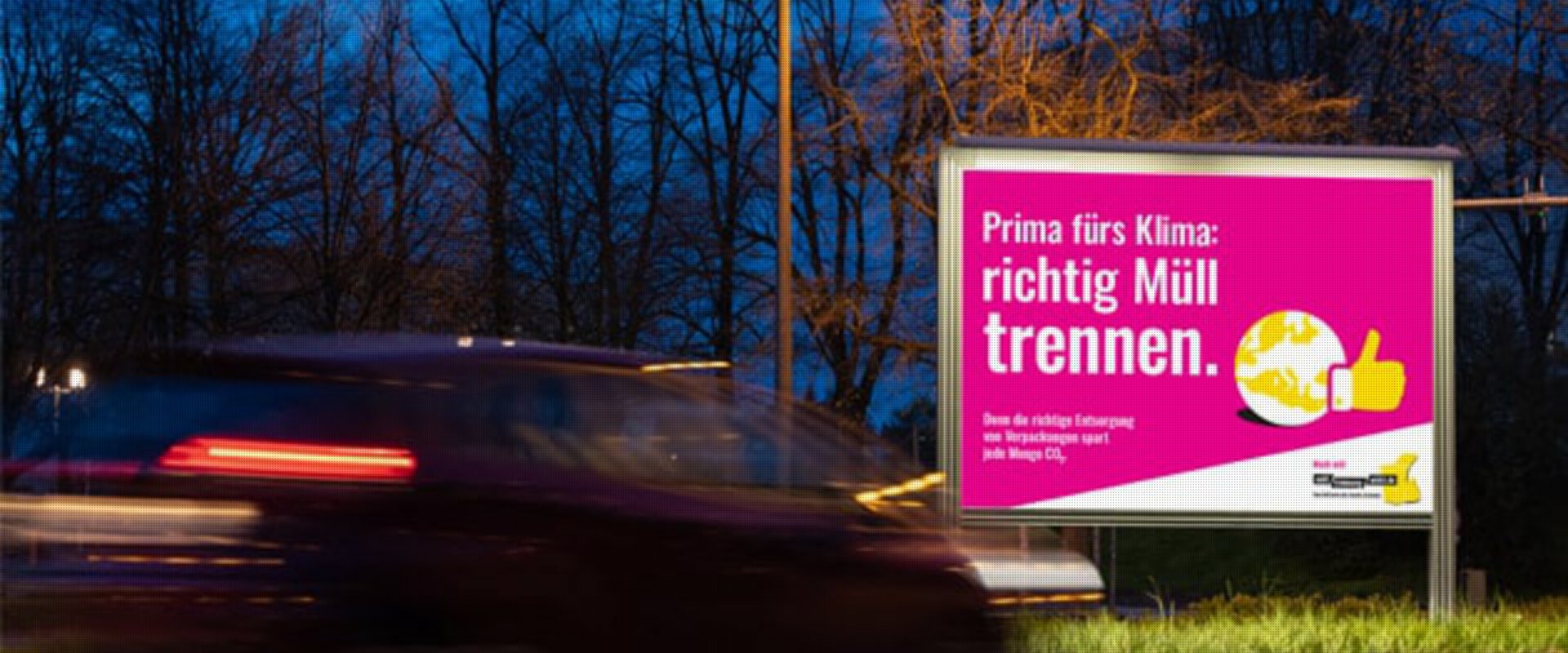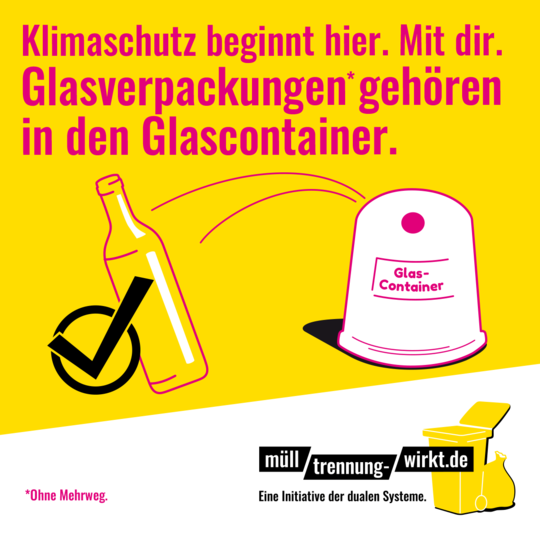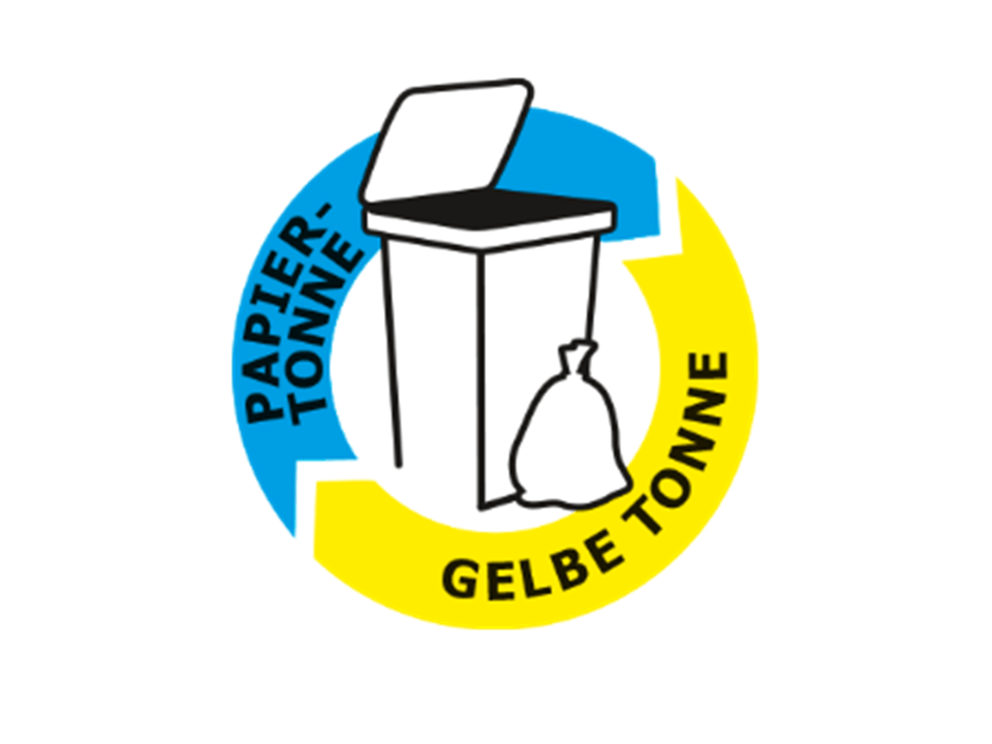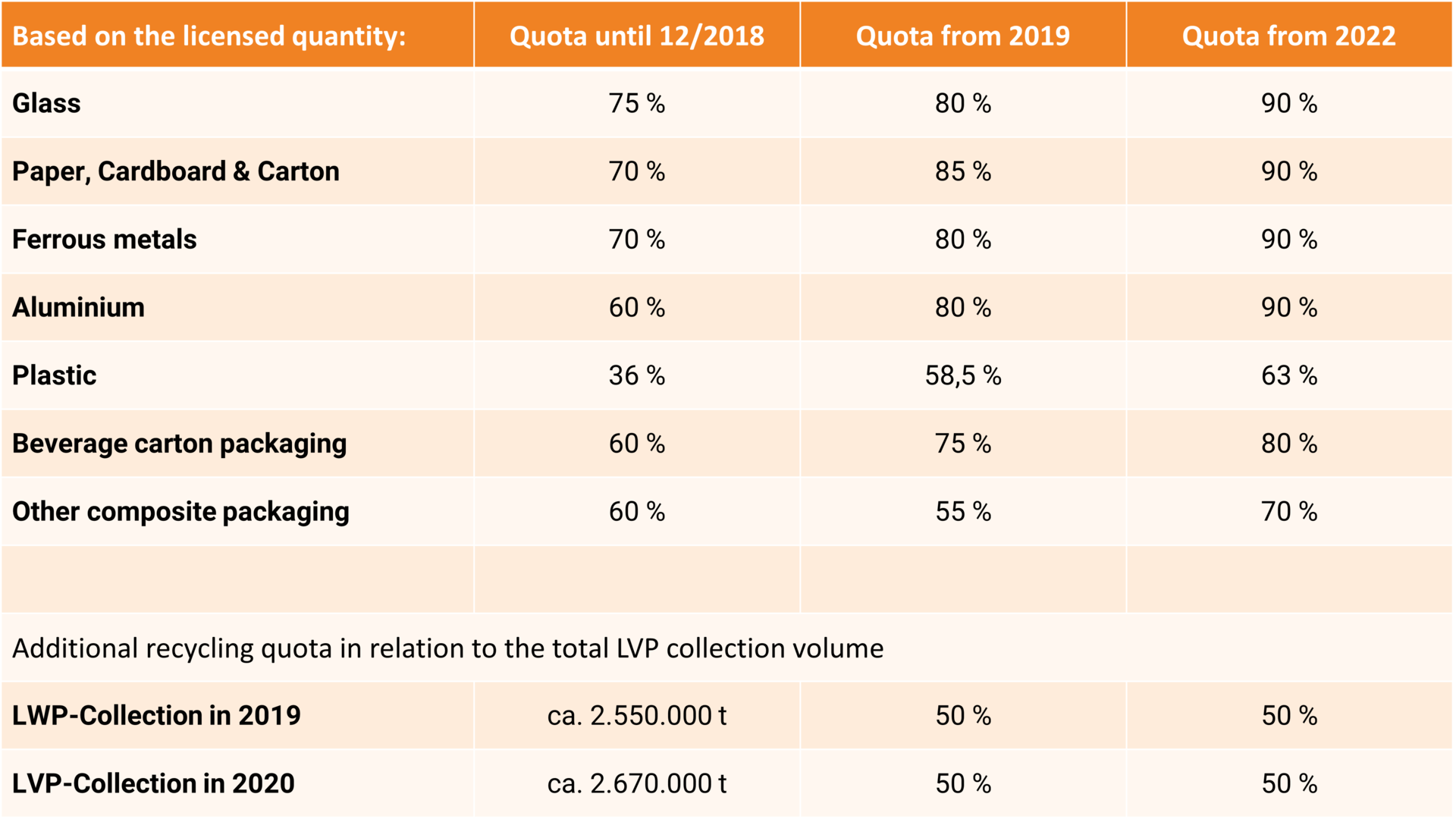
Let's separate together – waste separation protects the environment
Why do we need waste separation in Germany?
The resources that nature provides us with are finite - and yet every year we consume more raw materials than the earth can "produce" in the same period of time. In order to sustainably reduce the consumption of raw materials and the emission of climate-damaging CO2 gases, waste separation is an important component. Only if used packaging is disposed of separately from residual waste can packaging recycling - i.e. the reuse of used packaging - work and, for example, new packaging can be produced from recycled materials.
Because waste separation is so important for packaging recycling, the dual systems are educating consumers with their initiative "Muelltrennung wirkt!” The aim of the initiative is, on the one hand, to reduce the number of incorrectly thrown items in the yellow sacks or bins and therefore to improve the quality of the collection. On the other hand, the amount of packaging collected in the yellow sacks and bins has to be increased. This is because far too much packaging still ends up in the residual waste and is lost for recycling.

Paper bin, yellow bag, yellow bin & glass container - the right waste separation
Packaging is as varied as the goods that are packed in it. This repeatedly confronts consumers with the question: How do I separate my packaging waste correctly? Actually, separating waste is child's play and the following separation rules should be followed:
1. All packaging that is not made of glass, paper, cardboard or carton belongs in the yellow bag or the yellow bin.
2. Packaging made of paper, cardboard or carton belongs in the waste paper collection.
3. Glass packaging should be sorted by colour and placed in the waste glass container. Glass packaging that cannot be assigned by colour belongs to the green glass.
It is also important that the individual packaging components are disposed of separately: For example, the lid from the yoghurt pot or the caps from the tubes for mustard or tomato paste. The individual components are made of different materials, which are each fed into their own recycling cycles. Moreover, packaging should be empty when it is thrown away. This is because the materials can only be sorted cleanly if they are not too contaminated. However, rinsing the packaging is not necessary - "spoon clean" is sufficient.
If you are still unsure, you can find the right information here. With the separation tables of the initiative "Mülltrennung wirkt!":
|
|
|
Waste separation works “Mülltrennung wirkt” – also with producers and distributors

Many distributors have recognised the potential positive impact of packaging recycling for the environment and climate and are already educating end consumers on correct waste separation. Join them and become an official partner of the initiative "Mülltrennung wirkt!". In addition to the free advertising materials available in the internal area of the website www.muelltrennung-wirkt.de, there are also numerous other possibilities for cooperation.
Furthermore, you can directly guide end consumers to the correct waste separation of their packaging with separation instructions on your packaging, for example. You don't have your own separation labels? No problem. At www.trenn-hinweis.de you can download separation instructions that you can apply to your packaging free of charge. If you have any questions or are interested, please do not hesitate to contact us.
Because waste separation works: the more people participate, the more effective it is.
Further information on packaging recycling in Germany
The waste separated by citizens remains separate and is collected, sorted and recycled by the dual systems on behalf of industry and trade. Below you will find a lot more information and answers to the most important questions about the dual systems in general, the correct separation and disposal of waste, waste recovery or recycling as well as the occurrence and avoidance of packaging waste.
General information on the dual systems in Germany
Who are the dual systems?
The dual systems in Germany organise the nationwide collection, sorting and recovery of used sales packaging for industry and commerce so that the recycling quotas prescribed by law are achieved. For this purpose, industry and commerce each report their sales packaging quantities placed on the market according to material type and pay corresponding participation fees (commonly also called licence fees) to their dual system for the services to be provided. Currently there are eleven privately organised systems that fulfil this task together with their service providers from the waste management and recycling industry. The basis for the work of the dual systems is the current Packaging Act.
What do the collection systems of the dual systems look like?
The dual systems are responsible for the nationwide collection of used sales packaging. A distinction is made between collection and bring systems. The most widespread collection system is the pick-up system, in which the used packaging is collected directly from the private end consumer's home. Essentially, these are the paper bins, in which paper/cardboard is collected, and the yellow bag or yellow bin, in which all packaging, except that made of glass and paper/cardboard/cardboard, is collected.
In the bring system, on the other hand, consumers have collection containers at their disposal in the vicinity of their households. These containers are mainly for glass but sometimes also for paper packaging. In exceptional cases, packaging that is collected elsewhere via the yellow bag or the yellow bin is also collected in such containers in the bring system. In addition, there are recycling centres in certain regions where packaging can also be handed in along with a variety of other waste, such as bulky waste, waste electrical and electronic equipment, leftover paint, etc. The type of collection containers and the type of waste to be collected are described below. According to the Packaging Act, it is mainly the municipalities that decide on the type of collection containers and the disposal rhythms. In principle, however, the responsibility for organising and financing the collection, sorting and recycling of packaging lies with the dual systems.
What does the Packaging Act say?
All manufacturers and retailers (online and stationary) as well as importers and foreign exporters who put packaged goods on the market in Germany must participate in a dual system. "Participate" means they must conclude a contract with a dual system, report the quantities of packaging they put on the market and pay for the collection, sorting and recycling of this packaging. The manufacturers are responsible for the packaging of their products and the traders generally for the packaging of their own-brand products and additionally, for example, online traders for their mail-order packaging.
The dual systems, together with their service providers from the waste management and recycling industry, take over the collection, sorting and recycling of used packaging and ensure that the prescribed recycling quotas from the Packaging Act are achieved. All processes must be documented and proven by the dual systems and submitted to the inspection body via a volume flow certificate certified by an expert.
In addition, all manufacturers and retailers (online and stationary) as well as importers and foreign exporters who place packaged goods on the market in Germany must register with the Central Packaging Register Office. "Register" means they must deposit their company, product brands and contact data there in person. All registered companies are published on the internet so that anyone can check whether all companies that place packaging on the market have fulfilled their legal obligations. The companies must also report the quantities of sales packaging they have placed on the market and indicate with which dual system they participate.
Companies that do not participate their packaging in a dual system and/or do not register with the Central Authority are subject to a ban on the distribution of their products and must expect heavy fines.
How are the dual systems financed?
All manufacturers and retailers (online and stationary) as well as importers and foreign exporters who place packaged goods on the market in Germany must participate in a dual system and pay so-called participation fees (also commonly referred to as licence fees) to their dual system for implementing the collection, sorting and recovery of their packaging. The fees to be paid are generally included in the product price. The end consumer thus also pays for the disposal and recycling service when he buys the packaged goods. The amount depends on the weight and material of the packaging.
With their revenues, the dual systems essentially pay the waste management companies for their collection, sorting and recycling services, the municipalities for container stand space, cleaning of container stand space and waste counselling, the central office for its registration, testing and monitoring tasks as well as the service providers of the nationwide information campaign of the dual systems for consumers. In addition, the personnel and ancillary costs of the dual systems must be covered from the revenues.
What role do citizens play for the dual systems?
The collection and sorting behaviour of citizens is fundamental for successful recycling. Only if as much packaging as possible is collected and correctly separated can the high recycling rates prescribed by law be achieved.
Under no circumstances should used packaging be disposed of in the residual waste. This is because they are then incinerated and are no longer available for recycling. This also applies vice versa: Under no circumstances should residual waste end up in the collection containers for used packaging (yellow bin/yellow sack, paper bin, glass container). Residual waste has an extremely negative impact on the recycling of collected and correctly separated packaging, or in some cases makes it impossible. The legislator is aware of these interrelationships. Therefore, with the new Packaging Act 2019, in addition to increasing the recycling quotas, it has for the first time also made citizens responsible and legally required them to collect used packaging separately (§13 Packaging Act and explanatory memorandum).
Waste separation and disposal
Why should I separate the waste?
It is important: Only the recyclable materials from packaging that are collected via the Yellow Sack/Yellow Bin collection containers or via glass and paper containers remain in the cycle. Everything that ends up in the residual waste is mainly incinerated and thus lost to the cycle forever.
Can't modern machines do the separating?
Modern sorting plants are designed for sorting light packaging. Household waste on the sorting belts, which is sometimes interspersed with wet organic waste, makes sorting more difficult. In addition, the recyclability of the sorted recyclables is significantly reduced by contamination. In the past, there have been repeated attempts to collect residual waste and sales packaging in one bin and only separate them in the sorting plant. Unfortunately, the results were not satisfactory. Especially the often moist residual waste, such as kitchen waste, leftovers, tea bags or coffee filters, pollute the packaging waste enormously. This has a negative impact on the recyclability of the sales packaging and greatly reduces the quality of the secondary raw materials obtained.
Wouldn't it make more sense to incinerate the waste instead of laboriously sorting it?
The waste incineration plants in Germany basically offer an efficient and safe way to dispose of residual waste. However, they are not an alternative for the high-quality recycling of packaging. Every kilogramme of plastic packaging that the consumer puts in the yellow bag or the yellow bin saves climate-damaging CO2 compared to waste incineration, thus relieving the environment and saving valuable raw materials for future generations.
Where is the best place to dispose of waste?
The be-all and end-all of recycling is the clean separation of waste by citizens. In this way, they make a considerable contribution to recycling. As a rule, separate collection containers are available close to households for the following types of waste: so-called light packaging (LVP), which includes sales packaging made of plastic, aluminium, tinplate and composite materials, packaging waste made of paper/cardboard and glass, as well as residual waste and organic waste.
What collection containers are there?
a) Grey bin: Residual waste
b) Yellow sack/yellow bin: Light packaging made of plastic, aluminium, tinplate or composite materials such as beverage cartons (regionally also as recyclables bin or recycling centres)
c) Paper bin: paper/cardboard/cardboard
d) Glass collection containers: container glass and bottles
e) Organic waste bin: for organic waste
Where does my packaging waste belong?
What goes into the paper bin, what belongs in the glass container, what has to go into the yellow bag or the yellow bin? Practical separation aids for packaging waste are available for download here. Please note: Regional differences are possible. For example, if you have a recycling bin instead of a yellow bin, you can usually dispose of non-packaging of the same material, such as old plastic toys or frying pans, in the recycling bin. In some regions, citizens are requested to dispose of their packaging waste at the recycling centre. In case of doubt, please ask the responsible municipality or waste disposal company.
How do I dispose of my used coffee capsules?
This question is not so easy to answer. Since thousands of coffee capsules are used every day in Germany and then end up as waste, we have tried to provide clarification in a special section. You can find out how, when and why I should or should not dispose of my coffee capsules in the yellow bag or yellow bin HERE.
Waste recovery / recycling
Why do you recycle packaging?
Every year, around 60 per cent more resources are removed from the earth than can naturally grow back within the same period of time. Therefore, the recycling of valuable materials is an important task for mankind, because it is necessary to replace the previous one-time use of resources with circular economy. The recycling of packaging makes an important contribution to this.
Likewise, recycling protects the climate: The Öko-Institut has determined in a study that the separate collection and recycling of packaging by the dual systems in Germany makes an important contribution to climate protection. The recycling of lightweight packaging made of plastics, metals and composites reduces the burden on the environment by 1.9 million tonnes of greenhouse gases per year. The collection and recycling of glass and packaging paper additionally saves a good 1.15 million tonnes of CO2 equivalents, so that in total around 3.1 million tonnes of greenhouse gases are avoided per year.
What becomes of the different types of waste?
The recyclability and possible uses of the recycled waste depend on the source material:
▶ Metals such as aluminium and tinplate are melted down and processed into new screw caps or cans, for example. However, recovered metal raw materials can also be found in car bodies, refrigerators and other steel products.
▶ Waste glass is separated by colour, melted in the glassworks and formed into new glass packaging.
▶ Paper or cardboard packaging such as bread bags, biscuit boxes and shipping cartons in waste paper serve as a source of raw materials in the manufacture of new paper products, for example newsprint and transport cartons. In special sorting facilities, the paper is first separated into paper, cardboard and carton. The paper is then shredded in a recycling plant and mixed with water. This fibre pulp is washed, pressed, dried and then processed into new, printable paper, sanitary paper and cardboard.
▶ Plastics are sorted by type, such as polyethylene (PE), polypropylene (PP) or polyethylene terephalate (PET), among others, and reprocessed into plastic granulate of the same type using special recipes. These recyclates from used plastic packaging are already used in many production plants today and are reprocessed into packaging, pipes, household articles, storage and transport boxes, fleece fabrics, car parts and much more.
▶ Composite materials, such as beverage cartons and multilayer films, are recycled as far as possible according to the main material. For example, the paper fibres of beverage cartons are used for paper recycling and the aluminium and plastic residues are used as an additive in the cement industry.
What happens to the organic waste?
Compost or biogas is produced from biowaste. Compost from bio-waste stabilises and improves the humus content and valuable functions of our agricultural soils. Compost helps to replace the use of peat and has a positive effect on plants and the environment through its nutrients. The use of compost also reduces the emission of harmful climate gases. In many biowaste treatment plants, biowaste becomes real bioenergy in the form of biogas. This in turn is used to generate electricity. The bioelectricity thus comes directly from the bio-waste bin and can be used in households and as fuel for e-vehicles.
What happens to the residual waste?
In Germany, residual waste must be treated before it can be landfilled. This is mainly done by upstream energy recovery. The remains of the incineration, so-called slag, can be used for road construction, for example, or are landfilled. In Germany, the collection of residual waste is generally organised by the municipalities.
Occurrence and avoidance of packaging waste
Why is the amount of plastic waste, especially in the packaging sector, continuing to rise so sharply in Germany?
The reasons for this are manifold. Above all, new consumer trends are responsible for this, e.g. a significant increase in eating out or a significant increase in mail order. The trend towards more single households and stricter hygiene regulations also contribute to this.
What is the legislator doing to ensure that more plastic waste is recycled?
The new Packaging Act came into force on 01 January 2019 and stipulates significantly higher recycling quotas:

In addition, the dual systems are required by law to offer more favourable participation prices for recycling-friendly packaging for dual disposal. This is intended to motivate retailers and manufacturers to design their packaging in a recycling-friendly manner. Since the installation of the legal regulation for packaging disposal, the principle has been followed anyway that more packaging also leads to more disposal costs in order to provide an economic incentive to reduce packaging.
Why is there not more compostable packaging?
Biodegradable ("compostable") packaging is not a sensible alternative. The term "compostable" plastic packaging is misleading because after biodegradation there is practically no compost left that could be recycled. Such plastics only decompose, and only under optimal process conditions, for example in large-scale composting plants, but even there often not completely. In the view of the Federal Ministry for the Environment, the possibility of plastic residues entering the environment with biowaste compost cannot be ruled out. Outside of suitable large-scale facilities, such plastics degrade even more poorly or not at all - for example, in home composting. The attribute "biodegradable" can thus lead to careless handling in the form of uncontrolled disposal.